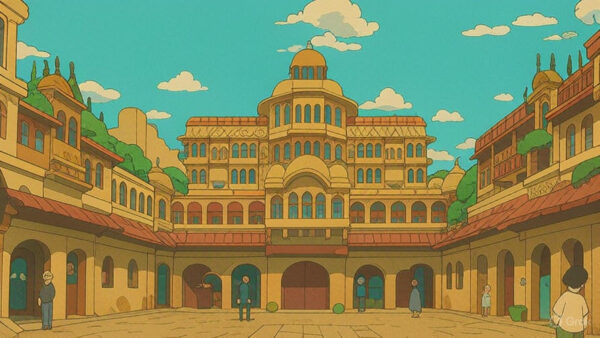Nestled at the foot of the Nahargarh hills, just a few kilometers away from the iconic Amer Fort and Jal Mahal, lies one of Jaipur’s most charming and lesser-known spots—Kanak Vrindavan Garden. A lush green oasis amidst the rugged terrain of Rajasthan, this beautiful garden is more than just a scenic escape. It’s a place where spirituality, nature, and royal elegance converge.

Kanak Vrindavan, often overshadowed by Jaipur’s more popular tourist destinations, is a site steeped in both historical significance and natural beauty. Whether you’re a photographer, a nature lover, a spiritual seeker, or a curious traveler, this tranquil garden offers a unique and peaceful retreat.
The Name and Its Significance
The garden gets its name from two distinct inspirations. The term “Kanak” refers to Maharaja Sawai Jai Singh, who commissioned the garden around 275 years ago, and was affectionately known as Kanak. The second part, “Vrindavan”, alludes to the holy town associated with Lord Krishna, drawing parallels between the serene landscape of this garden and the mythological Vrindavan where Krishna spent his youth.
`Legend has it that the garden was designed to resemble Vrindavan itself, complete with temples, fountains, floral walkways, and lush groves. It’s said that Lord Krishna’s idol at Govind Dev Ji Temple was worshipped here before being installed in the temple complex within the City Palace.
A Scenic and Spiritual Setting
Located in the valley surrounded by the Aravalli hills, Kanak Vrindavan Garden feels like a peaceful escape from the hustle and bustle of Jaipur. The Man Sagar Lake—home to the Jal Mahal—adds a shimmering foreground to the picturesque landscape, making the views from the garden even more captivating.
The garden is divided into several beautifully designed sections, each showcasing the regal charm of Mughal-style landscaping fused with Rajput architecture. Intricately designed fountains, well-trimmed hedges, marble decorations, and elegant chatris (domed pavilions) dot the landscape, evoking the ambiance of a royal retreat.
The Central Temple: Shri Govind Deo ji Temple
At the heart of the garden is the Shri Govind Deoji Temple, dedicated to Lord Krishna. The temple holds a special place in the hearts of devotees and history lovers alike. Built in white marble with delicate carvings, the temple exudes peace and divine beauty. Its sanctum is adorned with exquisite Rajasthani and Mughal designs, and it remains an active place of worship to this day.
Visitors often witness devotees performing rituals or singing bhajans, particularly during Krishna Janmashtami and other Vaishnav festivals. For many, the spiritual energy of the place makes it more than just a sightseeing stop.
The Garden Layout and Architecture
Kanak Vrindavan is meticulously laid out with multiple terraces, flowing water channels, and marble fountains. The most iconic of these is the Parikrama Marg, a semi-circular pathway lined with shrines and sculptures of deities like Krishna and Radha.
Some of the architectural highlights include:
- Garbh Griha: The sanctum of the temple, intricately carved in marble.
- Chhatris and Jharokhas: Rajput-style canopies and balconies that offer stunning views of the garden and hills.
- Marble Fountains: Inspired by Mughal gardens, these fountains add a touch of romance and tranquility.
The garden is not just about manicured beauty; it’s a living canvas of Jaipur’s rich past and architectural finesse.
Photography & Film Shoots
Due to its stunning visuals, Kanak Vrindavan has often been featured in Bollywood films and television serials. The symmetry of the fountains, the temple backdrop, and the panoramic views of the hills make it a favorite among photographers.
The golden light at sunrise or sunset turns the entire garden into a dreamscape—perfect for pre-wedding shoots, portraits, or peaceful nature photography.
Festivals and Celebrations
Though not as crowded as the Govind Dev Ji Temple, Kanak Vrindavan becomes lively during Janmashtami, Radha Ashtami, and Holi. Locals and pilgrims gather here to celebrate the life of Lord Krishna through dance, music, and vibrant rituals.
The garden’s natural acoustics and spiritual ambiance provide a beautiful setting for devotional programs and cultural events throughout the year.
How to Reach Kanak Vrindavan
- 📍 Location: Near Jal Mahal, on the way to Amer Fort, Jaipur, Rajasthan
- 🚗 Distance from Jaipur City Center: ~8 km (20 minutes by car)
- 🕒 Timings: 8:00 AM – 5:00 PM
- 🎟️ Entry Fee: Usually free or a nominal charge for maintenance (may vary)
It’s best to visit in the morning or late afternoon to enjoy pleasant weather and great lighting for photos.
Tips for Visitors
- Wear comfortable walking shoes as the garden area is spread out.
- Visit during weekdays to avoid crowds.
- Combine your trip with nearby attractions like Jal Mahal, Amer Fort, Nahargarh Fort, and Jaigarh Fort.
- Carry water and sun protection, especially during summer months.
- Photography is generally allowed, but avoid disrupting worship or rituals.
Why Kanak Vrindavan Deserves a Spot on Your Itinerary
While Jaipur is famous for its forts, palaces, and bustling bazaars, Kanak Vrindavan Garden offers a refreshing change of pace. It’s a place where you can soak in the beauty of nature, the serenity of devotion, and the legacy of royal craftsmanship—all in one location.
Often missed by the average tourist, this hidden gem lets you experience a more peaceful and soulful side of Jaipur, away from the crowds yet rich in culture and charm.
Final Thoughts
Kanak Vrindavan Garden is more than just a green patch on the tourist map—it’s a harmonious blend of mythology, nature, and royalty. Whether you visit for a few quiet moments, spiritual reflection, or cultural curiosity, you’ll leave feeling lighter and more connected to the timeless spirit of Jaipur.





One thought on “Kanak Vrindavan Garden : A Hidden Gem of Royal Serenity in Jaipur”